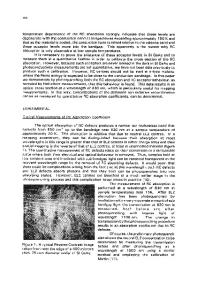Positive Hall coefficients obtained from contact misplacement on evident n -type ZnO films and crystals
- PDF / 234,510 Bytes
- 3 Pages / 612 x 792 pts (letter) Page_size
- 111 Downloads / 304 Views
Positive Hall coefficients obtained from contact misplacement on evident n-type ZnO films and crystals Takeshi Ohgaki,a) Naoki Ohashi, Shigeaki Sugimura,b) Haruki Ryoken, Isao Sakaguchi, Yutaka Adachi, and Hajime Haneda National Institute for Materials Science, Tsukuba, Ibaraki 305-0044, Japan (Received 4 April 2008; accepted 12 June 2008)
We report on the effect of sample non-uniformity on the results of Hall-effect measurements. False positive Hall coefficients were obtained from an evidently n-type ZnO single crystal, although four electrodes with low contact resistance were made and the Van der Pauw parameter for this electrode configuration was close to 1.00. Further position-sensitive characterization revealed that the false positive Hall coefficient was due to non-uniform electrical properties of the sample. To demonstrate a false positive sign of the Hall coefficient due to sample non-uniformity, we devised a model structure made from evident n-type ZnO thin film and successfully reproduced a false positive Hall coefficient from n-type ZnO.
Zinc oxide (ZnO) has potential optoelectronic applications such as light-emitting diodes (LEDs)1,2 (due to its excellent optical properties3), transparent transistors,4 and others. To utilize LEDs made from ZnO, further development on synthesis of p-type ZnO, which has a high concentration of relatively shallow acceptors, is needed. Many papers on the synthesis of p-type ZnO have been published, and they indicate that the appropriate dopants for obtaining p-type ZnO are nitrogen,2,5,6 phosphorus,7 and arsenic.8 However, despite these efforts, p-type ZnO still has reproducibility problems. In light of this situation, we feel that publishing reliable information on the carrier injection behavior in ZnO is the most important issue to the community of researchers investigating ZnO. Hall-effect measurement is one of the most popular ways to evaluate carrier concentration and mobility in semiconductors. In particular, Hall-effect measurements using the Van der Pauw geometry9 have been used to evaluate the transport properties of ZnO. Regarding p-ZnO, its electrical resistivity is higher than that of ordinary n-type ZnO because it has a lower hole concentration or less hole mobility.2,5,6 Consequently, there are many difficulties in measuring a proper Hall
a)
Address all correspondence to this author. e-mail: [email protected] b) Present address: Tokyo Denpa Co. Ltd. (TEW), 5-6-11 Chuo, Ohta-ku, Tokyo 143-0024, Japan DOI: 10.1557/JMR.2008.0300 J. Mater. Res., Vol. 23, No. 9, Sep 2008
http://journals.cambridge.org
Downloaded: 27 May 2014
coefficient (RH) for ZnO. For instance, we have to pay attention to local heating at the electrodes and thermal noise due to the non-uniform temperature distribution. It is known that the Van der Pauw method9 is appropriate for the evaluation of electrical resistivity of films and crystals. However, this method can only be used if the film thickness and electrical resistivity of the sample are uniform. That is, RH as measured with
Data Loading...











